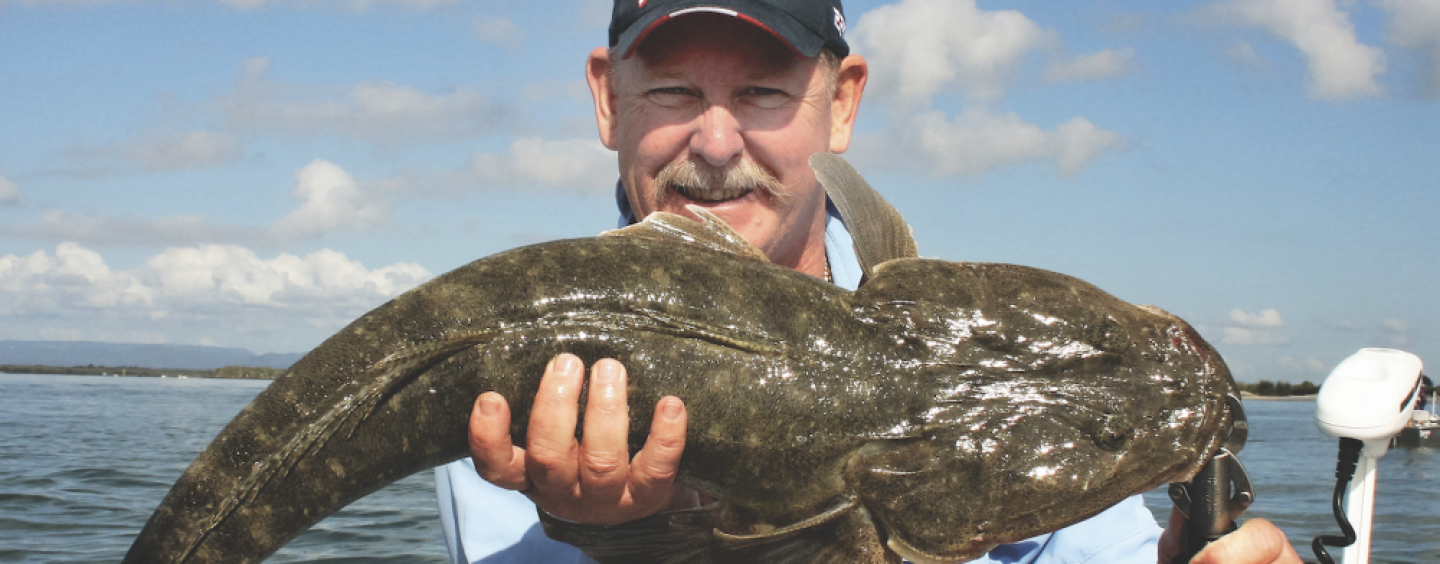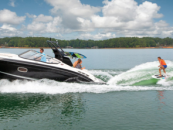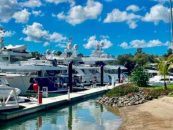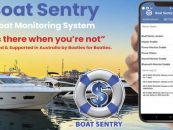Flathead is a very popular fish to catch in Australia. For this flathead season, KEVIN BALLANTINE and NIC WELCH offer very practical advice for catching the favourite fish in Gold Coast waters.
THE RIGHT CONDITIONS
The most productive areas for flathead are usually in close proximity to some form of weed bank. This may be an extensive shallow bank only accessible at high tide or just a single small outcrop on the edge of a small gutter. The flathead will position themselves in areas where the composition of the mud/sand bottom is extremely fertile, nutrient-rich, and provides the perfect environment for juvenile prawns, crab and baitfish to hide and grow quickly.
Large flathead can reside in deep water next to structures such as bridge pylons, wrecks, rock bars, submerged trees, and rock walls. However, most flathead are generally caught in 1-2m of water and congregate around the edges of sandbanks, weed banks, and mouths of shallow estuaries. They are also found in shallow waters, near oyster leases and mangroves.
TIDES AND TIMES
The best tides to fish for flathead are during the first three hours following the high tide, especially in areas where a large expanse of water drains over yabby banks. The flathead will lie in schools, head first, towards the current, camouflaged on the seabed, ready to ambush their unsuspecting prey.
Dawn and dusk are the best times to catch flathead. However, very large specimens can be caught during the night even at dead low tide, especially when using live bait. During calm weather, with less than 10 knots of breeze, is the most productive for flathead catching. Sometimes a shower of rain can trigger the fish to start feeding if it has been quiet beforehand.
EQUIPMENT
Rods and reels
Two rods will cover most situations. A 7’ 2-4kg spin rod is sensitive enough for trolling small hard bodied lures and is still perfect for throwing lightly weighted plastics long distances. For deeper and more current driven areas, stepping up to 4-6 kg rod will make using heavier jig heads and big plastics easier to handle, it will help you stop the big mulloway and trevally that frequent the same terrain.
A 2,000 or 2,500-sized reel is the perfect match for the 2-4kg rod, spooled with 3kg braid, and leadered up with 12lb fluorocarbon to make casting all day effortless. This light combo is more than capable of landing large flatties. The heavier of the two outfits can be either a 3,000-4,000 spin reel or a bait caster, 9kg braid with 20lb fluorocarbon to make a powerful combination able to stop just about anything.
If using bait, select a leader approximately 1m in length with a small ball sinker above the swivel. If anchored next to a run-off from a sandbank, choose the smallest ball sinker, which will allow your line to slowly drift with the current. Flick upstream into the shallows and let your line drift into deeper water, as the flathead will lie on the edge of the drop-off.
Lures
A 2-3inch deep diving hard body lure, or a 3-inch curly tail soft plastic, are effective lures for flathead, particularly around oyster leases.Bright pink or greeny-yellow colours work well.Use a slow retrieve with a twitching action. If trolling, troll in the direction of the current.
Quite often, the tide height will dictate which method is the most suitable. High tides allow access to shallow highest margins along banks, but the fish will be spread out and easy to spook; so, trolling small hard-bodied lures 30 to 40 metres back will allow more ground to be covered.
When the tide is about halfway through the run-out, clearly defined drains will have formed and it is here that numbers of flathead congregate, waiting to ambush anything that is trying to vacate the rapidly diminishing bank. Soft plastics are the go in this situation. A 3-4 in minnow or grub-style plastic matched to a lightly weighted jig head works well. Then slowly worked back from the head of the drain and worked all the way back, can provide explosive action.
Lures fall into two categories—hard and soft—and both are equally effective. Hard bodies are great for trolling and the simplest option when exploring new areas where ground needs to be covered. Locally made pig lures, Cultiva mira shads, Zerek Tango shads, and Tilsan minnows are popular. However, any bibbed lure in the 45-65mm range designed to swim between two and six feet will work. Flathead lure colours range from the wildest fluro creations to a variety of pinks, right down to natural transparent models that are a must when the water is crystal clear. Soft plastic variations can range from single and double tail grubs, minnows, shads, or vibes. Again, the colour choices are just as plentiful as the hardbodies. Atomic, Squidgy, Mcarthy, Samaki, Jackal, and Berkley brands provide a broad selection for all applications.
Baits
Live bait, such as herring, mullet, yabbies and prawns, are definitely the gun baits in the estuaries and are worth the extra effort to find. Dead bait include fresh WA pilchards, white and frogmouth pilchards, and strips of mullet or tailor. Choose a hook size appropriate to the bait you are using, with a hook gape of about 1cm. Suicide and bait holder hooks are good choices.
TECHNIQUES
Flathead respond and feed differently throughout the tidal cycle depending on the always changing water height. Run-in tides push clear water into the Broadwater via the Seaway and the Jumpinpin Bar, various bait species, such as garfish, pike, mullet, and whiting, move right onto the shallow banks and the flatties are not far behind them.
Natural coloured lures are favoured in these areas. Lure sizes can vary from a 50mm hard body right up to 220mm glide bait. The same goes for soft plastics, with some models reaching 300mm. These fish have huge mouths, so don’t think they won’t eat these; these are exactly what they want.
Chasing jumbo flathead with huge lures in skinny water is the ultimate challenge, with casting to sighted fish as exciting as you can get. As the tide peaks and starts to drop, all the fish move back to the safety of a deeper gutter where they wait for the last of the bait to vacate the bank. Drains that funnel the remaining water to the gutters are prime hotspots to work, and all methods are successful. Trolling small diving hard-bodied lures is a great way to find concentrations of fish. As the water dirties up, switching to fluoro and dark-coloured lures, preferably with some sort of ultra violet additive, can make a huge difference to catch rates.
As the tide bottoms out, huge areas of exposed banks will condense fish into a series of gutters and drains. Rods should be held when trolling as weed foul-ups are something that happen all the time. Sharply ripping the rod forward often dislodges the weed and gets the rod tip back to that nice wobble as the lure swims properly. Trolling flatties are often schooled up in a small area. This is the time to anchor up and cast soft plastics. It is great fun, and anyone who can cast a lure 15 metres will be able to experience the bone-jarring bite, as a big duskie inhales your lure. As the lure is often at the end of the retrieve, make sure you have a light drag and be patient playing it. Once it is close to the boat your net person should already have the net in the water. Swim the fish headfirst into the net, and he is yours. Lip grips are a fantastic holding tool when removing hooks, measuring, and taking that perfect shot without getting spiked. For bigger fish, the grips are perfect to allow them to swim and revive before release.
WHERE TO FIND FLATHEAD
-Along the break walls of the Southport Seaway.
-Just outside the entrance to Swan Bay on the southern end of North Stradbroke Island. (NB: Swan Bay itself is a marine park and all fishing is prohibited inside.)
Published in the August – November 2020 print edition.



























